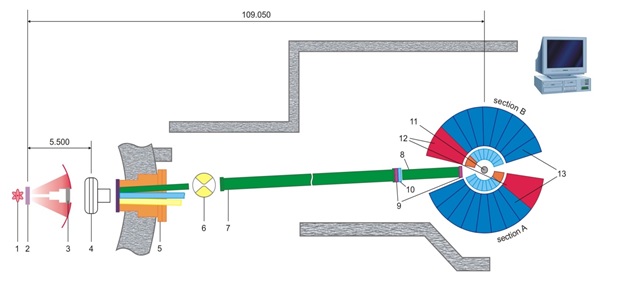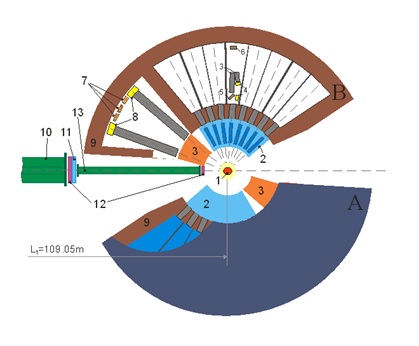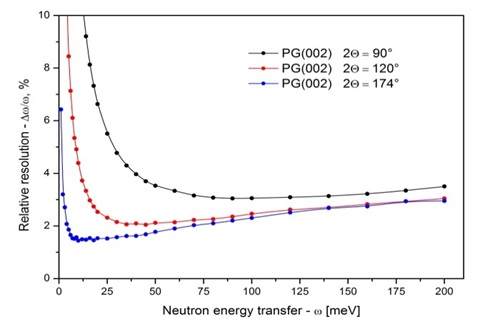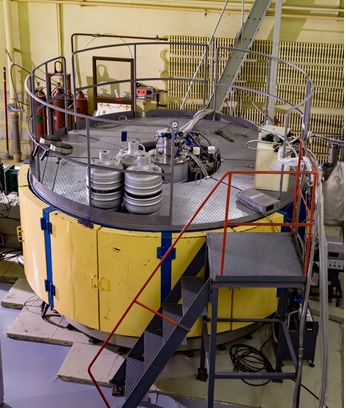Inverted geometry time-of-flight spectrometer

Fig. 1. The scheme of an inverted geometry NERA spectrometer
1 – IBR-2 reactor core
2 – thermal and cold moderators of radial horizontal beamlines 7-11 and tangential beamlines 1–9
3 – beam shutter
4 – fast neutron background chopper
5 – common vacuum splitter of three neutron beams by Ni-mirror neutron guides
6 – l-chopper of beamline 7b
7 – vacuum Ni-mirror guide tube of neutron beamline 7b
8 – vacuum sections of beamline 7b
9-10 – monitor and diaphragms of incident beam 7b, respectively
11 – sample position
12 – NPD sections
13 – INS and QENS sections of the NERA spectrometer.
Instrument Responsible:
Goremychkin Eugeny A.
Russia, Moscow reg., Dubna, Joliot-Curie str., 6
tel. +7 (49621) 6-54-86
e-mail: This email address is being protected from spambots. You need JavaScript enabled to view it.
Instrument Co-Responsible:
Dorota Chudoba
Russia, Moscow reg., Dubna, Joliot-Curie str., 6
tel. +7 (49621) 6-50-96
e-mail: This email address is being protected from spambots. You need JavaScript enabled to view it.
Inelastic Scattering Group Staff
Main research fields:
1. Dynamics and structure of condensed matter, particularly, of the substances exhibiting phase polymorphism;
2. Investigation of substances in which phase transitions are accompanied by changes in the structure, lattice dynamics or in the character of stochastic motion of molecules or molecular groups.
NERA - a multi-purpose inverse geometry spectrometer
NERA is an indirect geometry spectrometer designated predominantly for the study of molecular dynamics. The instrument is located at a distance of 100 m from the ambient water moderator at the end of the neutron guide. The recently installed cold (30K) neutron source increased the luminosity of the spectrometer by a factor of five at low energy transfer. The combination of a cooled beryllium filter and pyrolytic graphite analyzer provides the energy resolution at the elastic position ~ 0.7 meV with good intensity in the energy range up to ~ 120 meV. NERA can also be used as a diffractometer; the range of detected scattering angles provides good resolution in the Q-range (0.7 – 21 Å-1). The sample environment system on NERA permits inelastic and diffraction experiments at low temperatures (5K-300K) and high pressures up to 400 MPa.
The scientific program on NERA includes studies of hydrogen-bonded systems, biologically active materials, organic compounds; study of properties of dynamic complexes with transfer of electric charge, etc.

Fig. 2. Layout of neutron scattering detectors.
F1 – sample
2 – Be-filters
3 – collimators
4 – 3He detectors (INS and QNS)
5 – PG analyzers (INS)
6 – single crystal analyzers (QNS)
7 – detectors for high intensity diffraction
8 – diffraction detectors with good collimation
9 – spectrometer shielding
10 – Ni-coated mirror neutron guide in a vacuum tube
11-12 – diaphragms and monitor of incident beam 7b, respectively
13 – vacuum neutron guide.
Fig.3. View of NERA spectrometer
Basic parameters
| Neutron guide | Mirror, vacuum |
| Guide aperture | 50×160mm2 |
| Thermal neutron flux at sample position | 4.6×106n/cm2/s |
| Wavelength range | 0.8-7.0 Å |
| Scattering angles range | 10o-170o |
| Energy transfer range (INS) | 1-130 meV |
| Solid angle for INS | ~ 0.2 sr |
| Momentum transfer range (QNS) | 0.1-3.0 Å-1 |
| Moderator - sample distance | 109.5 m |
| Sample - detector distance | 0.815 m (INS with Be-filter) |
| 1.015 m (INS with single crystal) | |
| 1.745 m (high-resolution QNS) | |
| 1.415 m(neutron diffraction) | |
| Resolution | |
| Inelastic scattering | see Fig. 4 |
| Quasielastic scattering | DE=40-600 µeV |
| Neutron diffraction | D d/d=0.4% for l>1Å |
| Sample environment | Closed-cycle helium refrigerators (4-300 K and 100-400 K). High-pressure cell (up to 10 kbar) |

Fig. 4. Resolution for Inelastic scattering.



